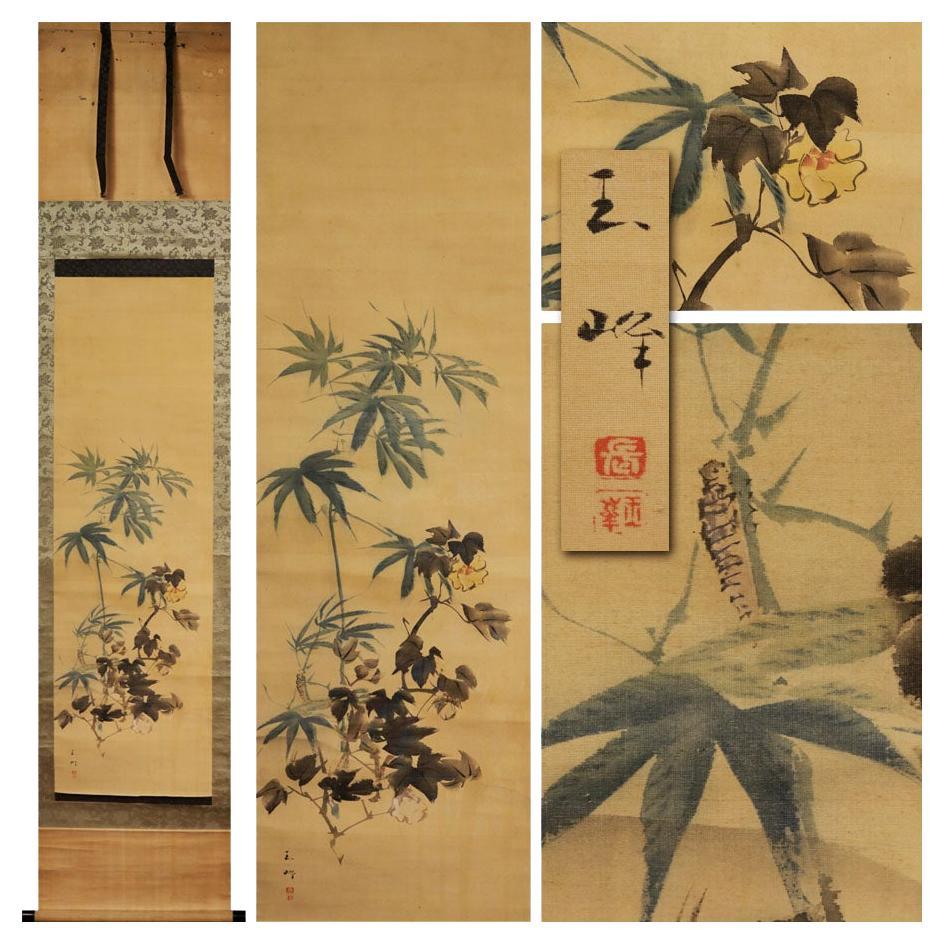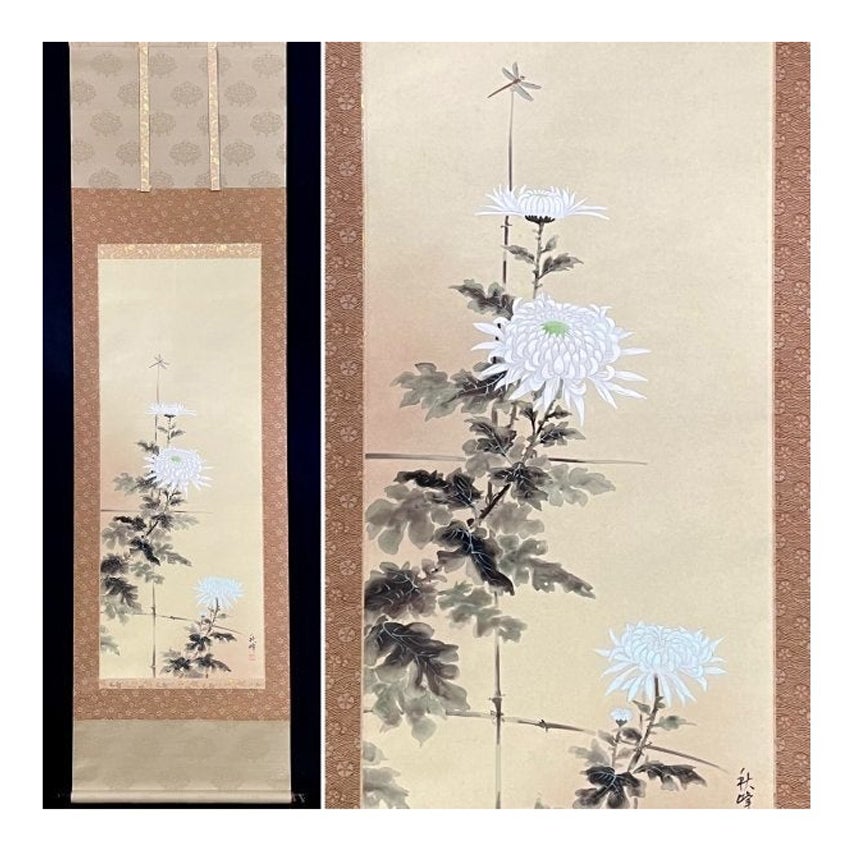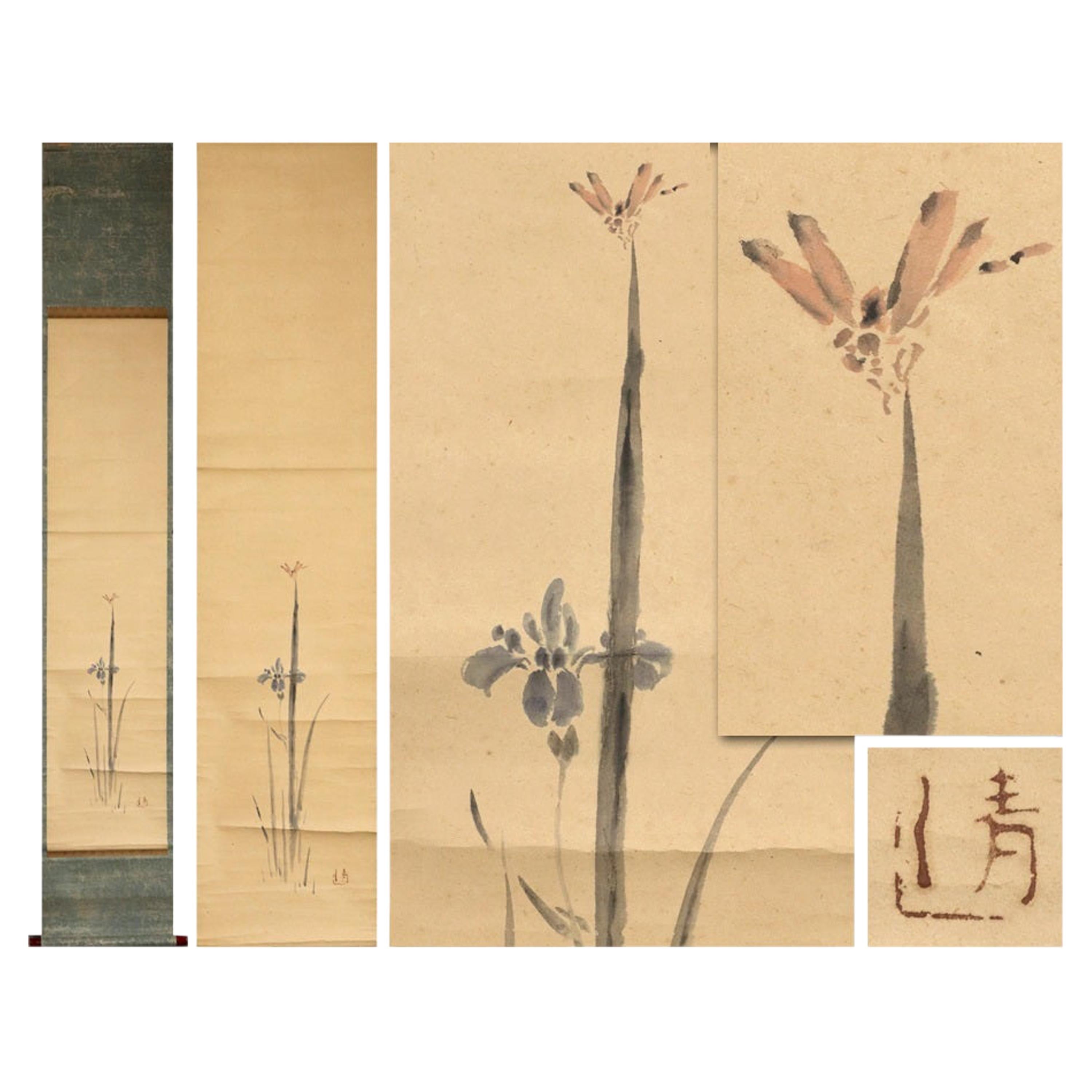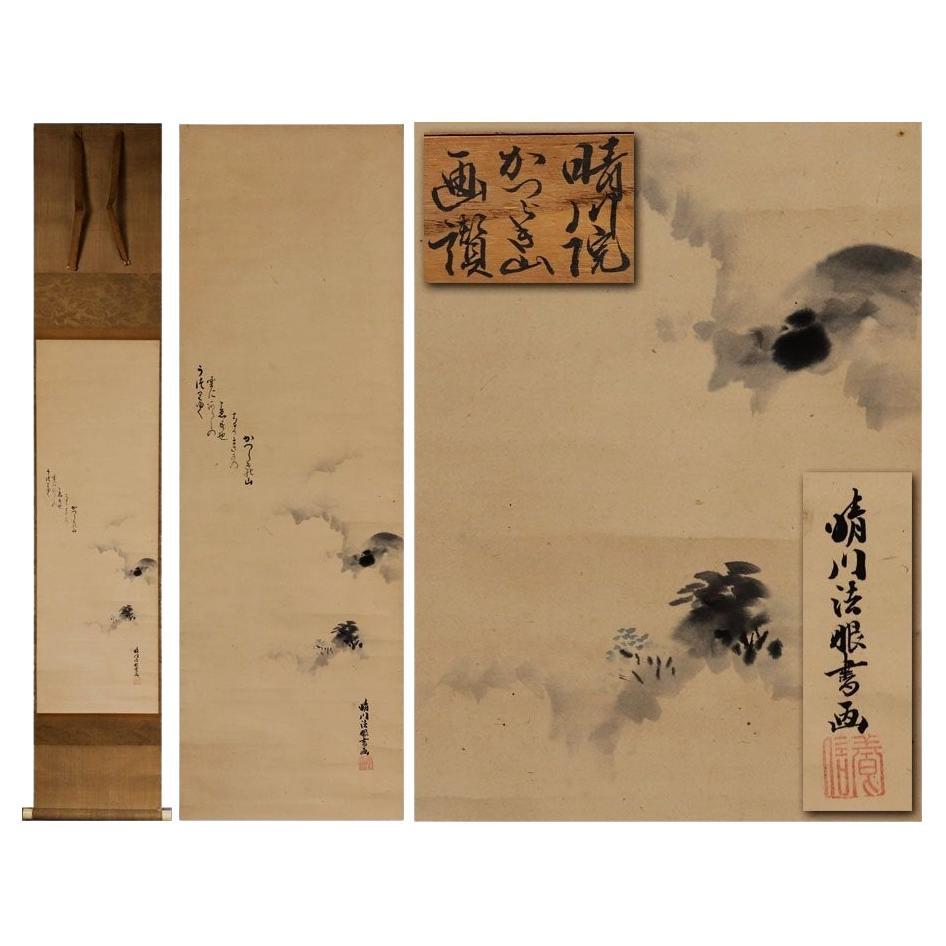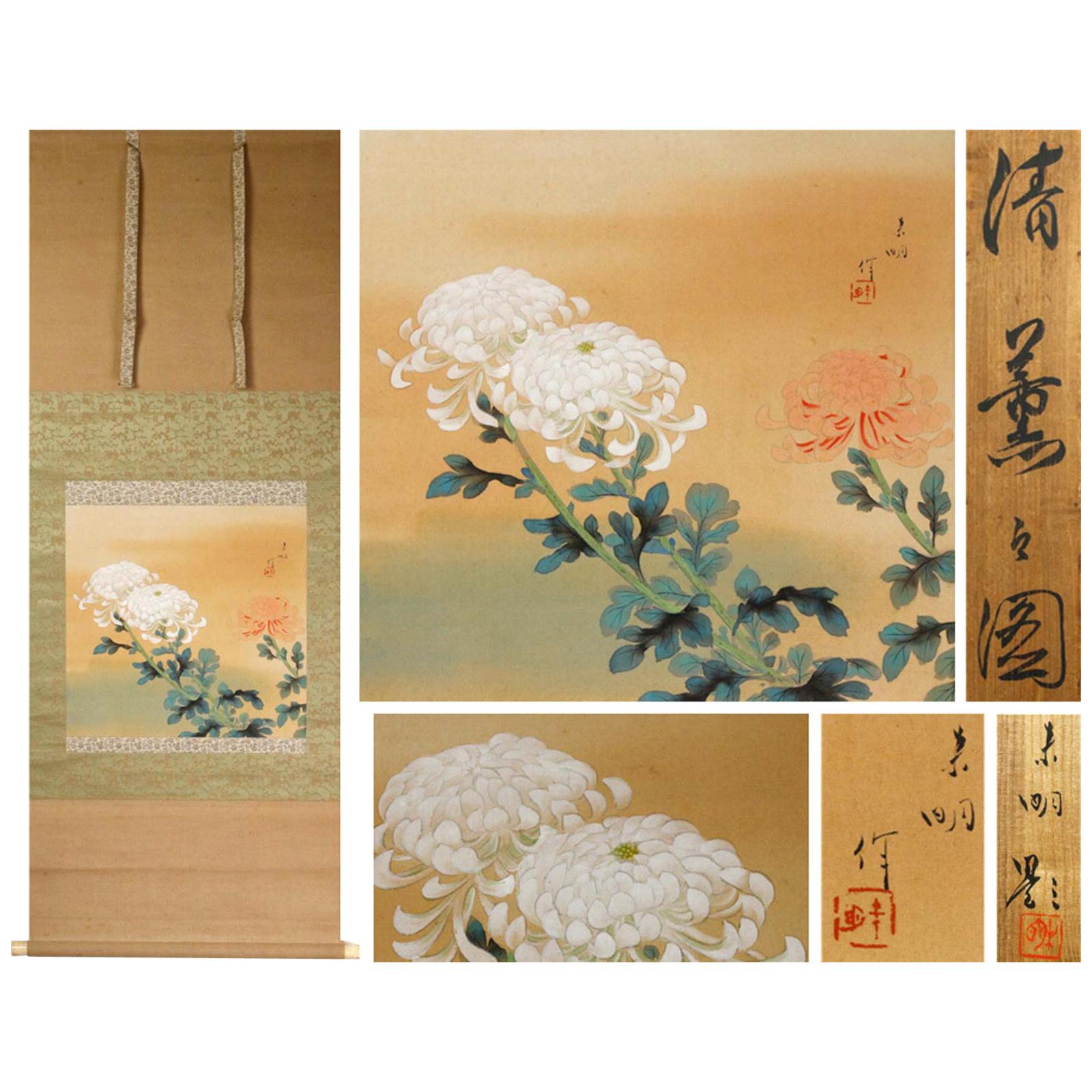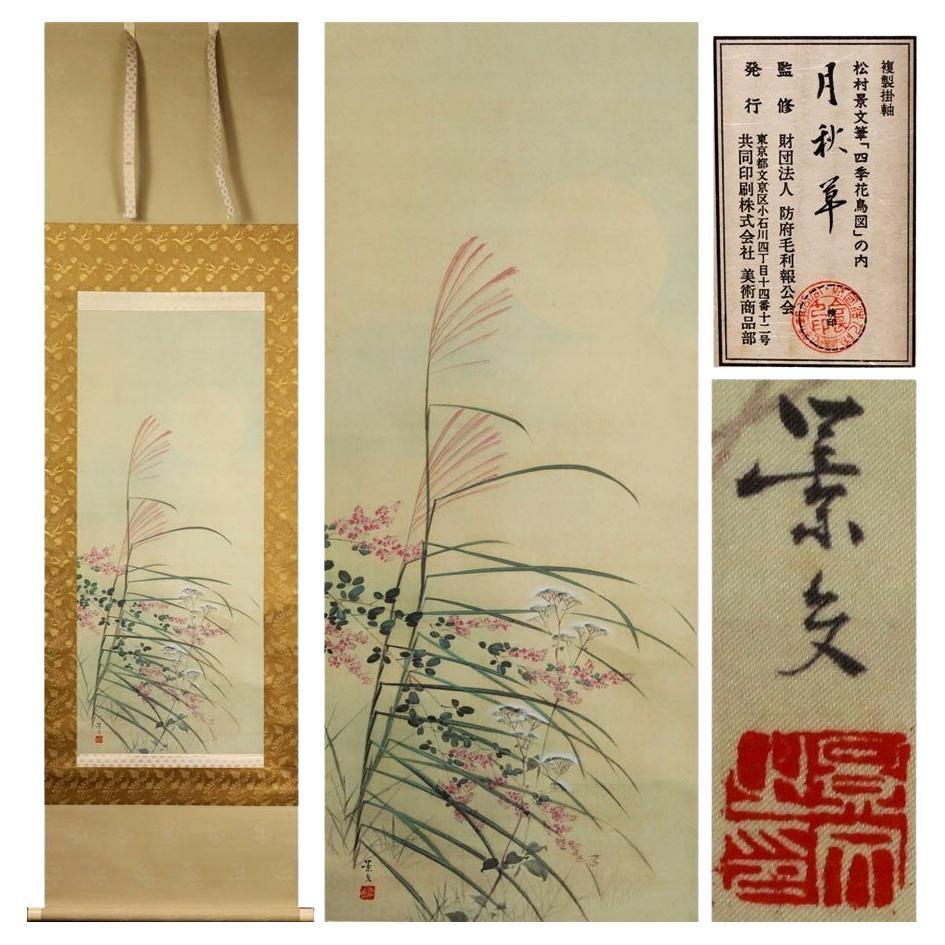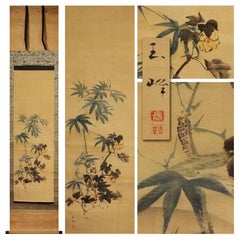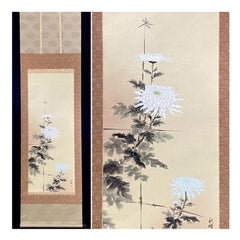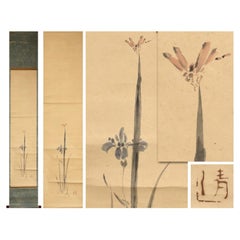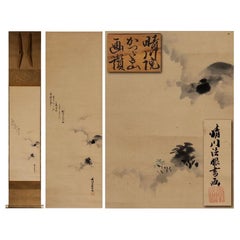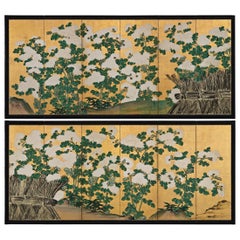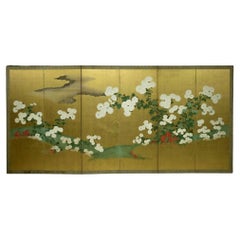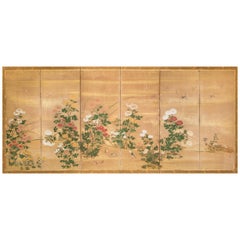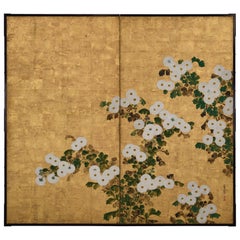Items Similar to Lovely Japanese 18th c Edo Scroll by Yoshinobu Kano (1747-1797), chrysanthemum
Want more images or videos?
Request additional images or videos from the seller
1 of 7
Lovely Japanese 18th c Edo Scroll by Yoshinobu Kano (1747-1797), chrysanthemum
$1,719.01
$2,148.7620% Off
£1,272.58
£1,590.7320% Off
€1,438.40
€1,79820% Off
CA$2,378.68
CA$2,973.3520% Off
A$2,622.04
A$3,277.5520% Off
CHF 1,371.97
CHF 1,714.9720% Off
MX$32,171.57
MX$40,214.4720% Off
NOK 17,270.44
NOK 21,588.0520% Off
SEK 16,150.59
SEK 20,188.2420% Off
DKK 10,951.97
DKK 13,689.9620% Off
About the Item
Yoshinobu Kano
(1747-1797) A Kano school painter who was active in the early Edo period.
Kano Yoshinobu was one of the top Kano School painters of his day. He was the son of Kano Gensen and was a student of Kano Toshu, the fourth- generation head of the Surugadai atelier. Training of Kano School painters was very strict and required long days of practice. He did quite well by himself to be ordained the rank of "Hogen" in 1785 at the age of 37 or 38 and must have been able to please the court nobles with his pieces. He was, as most high- ranking Kanō School painters were, a patronage painter. Paintings are hold by the Tokio National Museum, British Museum and Boston FIne art Museum.
■Silk, handpainted
■Condition: There are discolorations and scratches due to the age. (Two parts of the tip of one shaft are missing.)
■Dimensions Shaft dimensions: approx. 186.0cm x approx. 45.5cm. Main painting dimensions: approx. 103.5cm x approx. 38.5cm. ■Inscription There are inscriptions and inscriptions as shown.
■Box with box.
- Dimensions:Height: 73.23 in (186 cm)Width: 17.92 in (45.5 cm)Depth: 0.04 in (1 mm)
- Materials and Techniques:
- Period:
- Date of Manufacture:ca 1770
- Condition:Wear consistent with age and use.
- Seller Location:Amsterdam, NL
- Reference Number:Seller: 1328160530101stDibs: LU4863236883092
About the Seller
5.0
Gold Seller
Premium sellers maintaining a 4.3+ rating and 24-hour response times
Established in 2015
1stDibs seller since 2019
268 sales on 1stDibs
Typical response time: 6 hours
- ShippingRetrieving quote...Shipping from: Amsterdam, Netherlands
- Return Policy
Authenticity Guarantee
In the unlikely event there’s an issue with an item’s authenticity, contact us within 1 year for a full refund. DetailsMoney-Back Guarantee
If your item is not as described, is damaged in transit, or does not arrive, contact us within 7 days for a full refund. Details24-Hour Cancellation
You have a 24-hour grace period in which to reconsider your purchase, with no questions asked.Vetted Professional Sellers
Our world-class sellers must adhere to strict standards for service and quality, maintaining the integrity of our listings.Price-Match Guarantee
If you find that a seller listed the same item for a lower price elsewhere, we’ll match it.Trusted Global Delivery
Our best-in-class carrier network provides specialized shipping options worldwide, including custom delivery.More From This Seller
View AllLovely Japanese 18th c Edo Scroll by Tamamine Hasegawa , Flowers 19th c
Located in Amsterdam, Noord Holland
The following is a beautiful work of Fuyo drawn by Hasegawa using a skillful brush.
[Hasegawa]
1822-1879 Painter from the late Edo period to the Meiji period.
*Painter born...
Category
Antique 19th Century Edo Paintings
Materials
Silk
$1,719 Sale Price
20% Off
Lovely Japanese 20th c Scroll Chrysanthemum Nihonga Flower
Located in Amsterdam, Noord Holland
This work carefully and delicately depicts a Chrysanthemum
■Silk book, handwritten
■Condition
Lovely Condition
■Dimensions
Axis size: 1855mm (height) x 530mm (width)
Paper size: ...
Category
20th Century Paintings
Materials
Silk
$466 Sale Price
20% Off
Flower Scene Edo Period Scroll Japan 19c Artist Kiyoshi Watanabe
Located in Amsterdam, Noord Holland
As you can see, this is an old painting by Kiyoshi Watanabe, a colored iris and a red dragonfly.
It has a simple yet calm texture, and
the appearance of a red dragonfly standing li...
Category
Antique 18th Century Japanese Edo Paintings and Screens
Materials
Silk
$1,051 Sale Price
20% Off
Lovely Japanese 18/19th c Edo Scroll Kano Osanobu Nihonga Painting Mountain
Located in Amsterdam, Noord Holland
Kano Osanobu (狩野養信)
Osanobu Kano (born August 18, 1796; died June 12, 1846) was the ninth painter of the Kobikicho Kano School in the Edo period. His common name was Shozaburo. His father was Naganobu KANO, and Tadanobu KANO was his son. His Go (pen name) was Osanobu Seisenin, Kaishinsai, and Gyokusen.
Brief Personal History
He was born the eldest son of Naganobu ISENIN during the Edo period. He was first sent to serve at Edo Castle at the age of 15, and it appears that he was apparently pushed by his father to perform various public tasks for the Kanon School. He kept a diary for 36 years, starting from the day before he first went into service at Edo Castle until the day before he died. The diary is entitles "Official Service Diary" (it consists of 52 volumes that are maintained at the Tokyo National Museum, and 4 volumes that are separately maintained at the different families), and have become the focus of a lot of attention in recent years for the detailed information they present on the daily life and work of a prestigious official painter. The reading of the characters of his name was originally "Takenobu"; however, with the birth of the first son of the Shongun Ieyoshi TOKUGAWA in 1813, whose name was Takechiyo, having a sylable with the same pronunciation of "Take"was deemed to be inappropriate, and was therefore changed to "Osanobu". Because Takenobu died the following year, after which he was referred to as Gyokujuin, Osanobu changed his pen name Gyokusen he had used until that point to Seisenin, in order to avoid using the same Chinese charcter pronounced alike. In 1819, he attained the second highest rank for a Buddhist priest, Hogen, and assumed the role of head of the family after his father passed away in 1828. In 1834 he attained the highest rank for a Buddhist priest, Hoin. He oversaw the rennovation of the wall paintings of Nishinomaru Palace of Edo Castle from 1838 to 1839, and Honmaru Palace of it from 1844 to 1846. It is thought that Osanobu later died due to the fatigue...
Category
Antique 18th Century Edo Paintings
Materials
Silk
$1,719 Sale Price
20% Off
Lovely Scroll Painting Japan, 20th Century 'Showa' Artist Flower
Located in Amsterdam, Noord Holland
Overall perfect: Size scroll... 142.0cm × about 55.0cm. Painting about 40.0cm × about 41.5cm.
30-12-18-1-11 (65)
Condition
Overall Perfect: Size scroll... 142.0cm × about 55.0cm...
Category
20th Century Japanese Showa Paintings and Screens
Materials
Fabric
$717 Sale Price
20% Off
Japanese Scroll with an Official Printed Version of Keifumi Matsumura Flowers
Located in Amsterdam, Noord Holland
Absolute Top Quality Print of this famous painting. Mid 20th century
This is the autumn version of the Four Seasons Flowers and Birds series, an...
Category
20th Century Paintings
Materials
Silk
$552 Sale Price
20% Off
You May Also Like
Mid-18th Century Japanese Screen Pair, One Hundred Flowers, Chrysanthemums
Located in Kyoto, JP
Omori Soun (b. 1704)
Chrysanthemums - One Hundred Flowers
A Pair of Six-fold Japanese Screens. Ink, color, gofun and gold leaf on paper.
Dating ...
Category
Antique Mid-18th Century Japanese Edo Paintings and Screens
Materials
Gold Leaf
Late Edo Period Rinpa School Chrysanthemum Blossom Screen
By Rimpa School
Located in Fukuoka, JP
Late Edo Period Rinpa School Chrysanthemum Blossom Screen
Period: late Edo, early 19th century
Size: 364 x 172 cm (143 x 67 inches)
SKU: PTA13
This exquisite late Edo period Rinpa ...
Category
Antique 18th Century Japanese Edo Paintings and Screens
Materials
Paper
Japanese Six-Panel Screen, Chrysanthemums
Located in Hudson, NY
Japanese six-panel screen: Chrysanthemums, Edo period (circa 1800) painting of a variety of chrysanthemums in a garden landscape, with sparrows. Mineral p...
Category
Antique Early 1800s Japanese Edo Paintings and Screens
Materials
Gold Leaf
18th Century Japanese Rinpa Screen. White Chrysanthemums. School of Korin.
Located in Kyoto, JP
School of Ogata Korin
White Chrysanthemums
18th Century, Edo period.
A two-panel Japanese screen. Ink, color, gofun and gold leaf on paper.
Dimensions: H. 171 cm x W. 188 cm (67.5” x 74”)
On this two-panel Japanese screen we see blooming chrysanthemums, a flower which embodies the essence of autumn in Japan. Here the traditional floral theme has been simplified and stylized. The bright colors and asymmetrical composition against the delicate gold leaf create a luxurious and ornate work of art. Its background, a strikingly patinated grid of gold leaf, denies any sense of place or time and imbues everything with an ethereal glow. The leaves and stems of the plants are nothing more than pools of mottled color and ink without any outline whatsoever. These are typical Rinpa adaptations of traditional ink painting methods; tarashikomi, or diluted washes of color blended while very wet, and mokkotsu, or “bonelessness,” which creates forms without exterior outlines. The relief work of the rounded flower petals has been obtained by the moriage process (a mixture based on ground shells modeled on the surface of the paper).
On the lower right of the screen, the siganture “Hokyo Korin Jakumyo” and the “Hoshuku” seal can be read. Korin is Ogata Korin, famed for the Irises (Nezu Museum) and Red and White Plum Blossom (MOA Museum of Art) folding screens, both National Treasures. Korin worked in both Kyoto and Edo in the mid-Edo period. Korin was using the art name “Jakumyo” just after he received the Hokyo level, which was in 1701.
This particular screen was published in May of 1961 in the Japanese Sansai Fine Art Magazine*. An in depth article accompanies the photograph of the screen and and a photograph of the signature and seal. This article devotes much of its body to discussing the moriage technique, how it enlivens the chrysanthemum flowers and Korin’s specific skill in using the technique. The article goes on to discuss the most famous works of Korin, utilizing this technique, which were known at the time. Specifically a two-panel screen held in the Honolulu Museum which was discovered in the store-house of Takahashi Soan. A two-panel screen pair which the Nakano family own. A two-panel screen pair with chrysanthemums in moriage in fan designs owned by the Nomura family. Also a small folding screen featuring chrysanthemums held in the Yamato Bunkakan. The article goes on to say that this particular two-fold screen came from the Nijo family. Korin is known to have had a strong connection with the aristocratic Nijo family. The article explains that Korin received a lot of favors from the Nijo family and that this screen would have been gifted to them.
Since that time the Honolulu screen has been amended to ‘attributed to Ogata Korin’ and I do not know further details of the other 3 screens. Other Chrysanthemum screens...
Category
Antique 18th Century Japanese Edo Paintings and Screens
Materials
Gold Leaf
Japanese Two-Panel Screen, Summer Flowers on Silk
Located in Hudson, NY
Rimpa painting of flowers including morning glories, hollyhocks, sweet peas, nadeshiko, and daisies. Signature and seal read: Bisui
Category
Antique Late 19th Century Japanese Meiji Paintings and Screens
Materials
Silk, Wood
19th Century Japanese Scroll Painting by Igarashi Chikusa, Poppies & Butterflies
Located in Kyoto, JP
Poppies & Butterflies
Ink, pigment and gofun on silk
Igarashi Chikusa (1774-1844)
Signature: Chikusa Ran Zen
Upper Seal: Ran Shuzen
Lower Seal: Kyoho
Dimensions:
Scroll: H. 68” x W. 18” (172cm x 45cm)
Image: H. 38.5’’ x W. 12.5’’ (98cm x 32cm)
This composition shows elegant images of poppies and the butterflies that are inevitably drawn to them. It captures a momentary glimpse into a world both visually dazzling and startlingly realistic. The painting is infused with sensitivity and attention to seasonal change and weather conditions. The thin and fragile poppies are beautifully depicted with brilliant colors and the butterflies are similarly infused with life. The painting is on silk which requires extremely precise painting skills as no element once painted can be removed.
Poppies were a favorite subject of Rinpa school artists through the ages. Originally they were somewhat abstracted but by the age of Sakai Hoitsu...
Category
Antique Early 19th Century Japanese Edo Paintings and Screens
Materials
Silk
